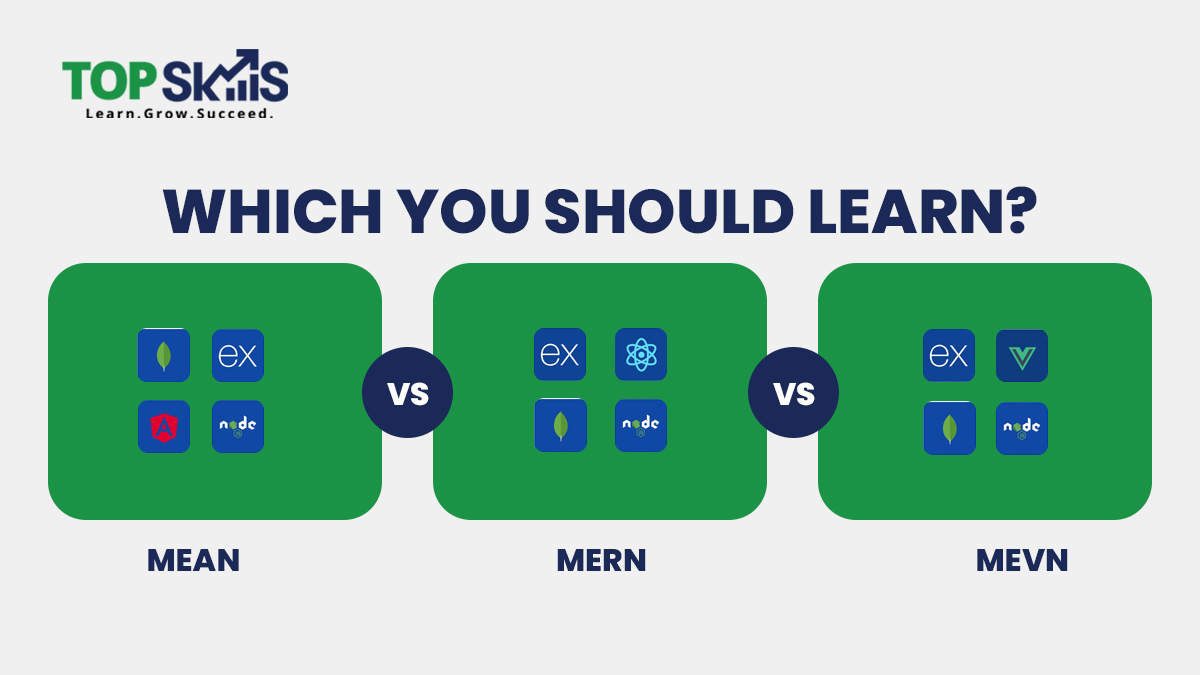In the dynamic world of web development, choosing the right technology stack can make or break your project. With so many options available, it can be challenging to decide which stack is best suited for your career goals or specific project needs. Three of the most popular stacks in the industry today are MEAN, MERN, and MEVN.
Before diving into the details of these stacks, let’s first understand what a stack is.
What is a Stack?
A stack in web development refers to a collection of technologies that work together to build and run a web application. These technologies typically include a database, a server, a front-end framework, and a back-end runtime environment. The idea behind a stack is to use a set of tools that complement each other to provide a cohesive solution for full-stack development.
Stacks are categorized as full-stack, back-end, or front-end, depending on their function. Full-stack developers are skilled in all three areas, allowing them to build an entire web application from the ground up. Now, let’s explore the specifics of the MEAN, MERN, and MEVN stacks.
What is MEAN Stack?
The MEAN stack is a JavaScript-based technology stack used to build dynamic web applications. It is named after the four key technologies it encompasses: MongoDB, Express.js, Angular, and Node.js.
Components of MEAN Stack
MongoDB: A NoSQL database that stores data in flexible, JSON-like documents, making it ideal for handling large volumes of unstructured data.
Express.js: A minimal and flexible Node.js web application framework that provides a robust set of features for building single and multi-page web applications.
Angular: A TypeScript-based front-end web application framework developed by Google. It is designed to make the process of building complex applications more straightforward.
Node.js: A JavaScript runtime that executes server-side code, enabling the development of scalable and efficient network applications.
Benefits of MEAN Stack
Full-Stack JavaScript: Since all components are based on JavaScript, developers can use a single language throughout the stack, simplifying development and reducing the learning curve.
Cost-Effective: As an open-source stack, MEAN is free to use, which makes it a cost-effective solution for startups and small businesses.
Scalability: MongoDB and Node.js are designed for scalability, making the MEAN stack an excellent choice for building large-scale applications.
Community Support: MEAN has a strong community, offering numerous libraries, tools, and resources to speed up development.
Disadvantages of MEAN Stack
Learning Curve with Angular: Angular can be complex and has a steep learning curve, especially for developers unfamiliar with TypeScript.
Limited Flexibility: The opinionated nature of Angular can be restrictive for developers who prefer more flexibility in their frameworks.
What is MERN Stack?
The MERN stack is another popular JavaScript-based stack, very similar to MEAN, but it replaces Angular with React.js, a library developed by Facebook.
Components of MERN Stack
MongoDB: Same as in MEAN, a NoSQL database for storing data in JSON-like documents.
Express.js: A minimal web application framework for Node.js.
React.js: A front-end library for building user interfaces, particularly single-page applications where data needs to be dynamically displayed.
Node.js: JavaScript runtime for server-side execution.
Benefits of MERN Stack
React’s Flexibility: React is more flexible than Angular, allowing developers to build UIs using a component-based approach. This makes it easier to manage large-scale applications.
Rich User Interfaces: React enables developers to create highly dynamic and responsive user interfaces.
Performance: React’s virtual DOM improves the performance of applications by updating only the parts of the UI that have changed.
Wide Adoption: React has widespread adoption in the industry, leading to a wealth of resources, tutorials, and community support.
Disadvantages of MERN Stack
Limited Structure: Unlike Angular, React does not impose a strict project structure, which can lead to inconsistencies in larger projects.
SEO Challenges: React applications can have difficulties with search engine optimization (SEO) if not implemented correctly.
What is MEVN Stack?
The MEVN stack is a variation of the MEAN stack that swaps Angular for Vue.js, a progressive JavaScript framework.
Components of MEVN Stack
MongoDB: A NoSQL database as used in MEAN and MERN.
Express.js: A back-end framework for Node.js.
Vue.js: A progressive JavaScript framework used for building user interfaces, designed to be incrementally adoptable.
Node.js: JavaScript runtime for executing server-side code.
Benefits of MEVN Stack
Ease of Learning: Vue.js is considered easier to learn than Angular or React, making it a great choice for beginners.
Flexibility: Vue.js offers a balance between the structure of Angular and the flexibility of React, providing a simple and intuitive development experience.
Performance: Vue.js is lightweight and performs well, especially in small to medium-sized applications.
Growing Community: Although smaller than React or Angular, Vue’s community is rapidly growing, offering a wide range of plugins and tools.
Disadvantages of MEVN Stack
Smaller Ecosystem: Vue.js has a smaller ecosystem compared to React or Angular, which can limit the availability of third-party tools and libraries.
Enterprise Adoption: Vue.js is less commonly adopted in large enterprises, which may limit job opportunities in some regions.
MEAN vs. MERN vs. MEVN Comparison
Below is a table highlighting the major differences between the three stacks:
| Feature | MEAN Stack | MERN Stack | MEVN Stack |
| Front-End | Angular (TypeScript-based) | React (JavaScript-based) | Vue.js (JavaScript-based) |
| Learning Curve | Steep due to Angular | Moderate with React | Easiest with Vue.js |
| Flexibility | Less flexible | Highly flexible | Balanced flexibility |
| Performance | Good but complex | High due to Virtual DOM | Good with lightweight structure |
| Community Support | Strong and mature | Very large and active | Growing rapidly |
| Project Structure | Opinionated (Angular) | Unopinionated (React) | Balanced (Vue.js) |
| Best For | Enterprise-level applications | Dynamic user interfaces | Beginners and small projects |
Why Choose Top Skills for Web Development Courses?
Choosing the right stack is crucial for your success as a web developer, but learning it effectively is equally important. At our IT institute in Pakistan, we specialize in teaching the latest and most in-demand web development stacks, including MEAN, MERN, and MEVN. Here’s why you should consider joining our courses:
Comprehensive Curriculum: We offer a well-structured curriculum that covers all aspects of web development, from front-end to back-end, ensuring you become a proficient full-stack developer.
Experienced Instructors: Our instructors are industry experts with years of experience in web development, ready to guide you through hands-on projects and real-world scenarios.
Flexible Learning: Whether you’re a beginner or looking to upskill, our courses are designed to fit your learning pace and career goals.
State-of-the-Art Facilities: Our institute is equipped with the latest tools and technologies, providing you with the best environment to learn and grow.
Career Support: We offer career guidance and job placement assistance, helping you land your dream job in web development.
Community and Networking: Join a community of like-minded learners and professionals, where you can share knowledge, collaborate, and grow together.
Unlock your potential with our web development courses and become a part of Pakistan’s growing tech industry. Whether you choose MEAN, MERN, or MEVN, we have the right course for you. Contact us today and learn professional web development with us!





